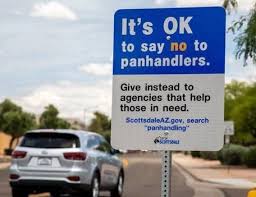By Ronald Sampson

Effective September 25, 2025, Scottsdale implemented a new ordinance making it illegal to stand on traffic medians for more than two traffic light cycles on streets with speed limits above 30 mph. Violators face Class 3 misdemeanor charges, with potential fines up to $500 and jail time up to 30 days.
While city officials frame this as a traffic safety measure, it’s relatively obvious what this ordinance is really targeting: panhandling. Scottsdale Police Public Information Officer Aaron Bolin acknowledged as much, noting the challenges of people “trying to solicit for money” in the heat and directing them toward city resources like food banks instead.
The ordinance allows brief use of medians as crossing refuges but prohibits extended stays, a distinction that clearly separates legitimate pedestrian use from solicitation activities. Critics have rightfully pointed out that this essentially criminalizes homelessness and poverty, turning a social issue into a legal one.
Let’s be honest: none of us particularly enjoy being approached by panhandlers, and their presence on busy medians isn’t exactly the postcard image that tourism-dependent Scottsdale wants to project. The city’s economy thrives on its reputation as an upscale desert destination, and visible homelessness can undermine that carefully cultivated brand.
However, it’s unfortunate that it takes a law like this to address the problem. Rather than tackling root causes like affordable housing, mental health services, and job training programs, the city has chosen the path of criminalization. While the ordinance may clear the medians, it doesn’t make homelessness disappear; it simply pushes it elsewhere or forces it underground.
Scottsdale’s approach reflects a broader trend of cities using ordinances to manage visible poverty rather than investing in comprehensive solutions. While the immediate safety and aesthetic concerns may be addressed, the underlying issues that drive people to panhandle remain unresolved, making this feel more like municipal theater than meaningful policy.

